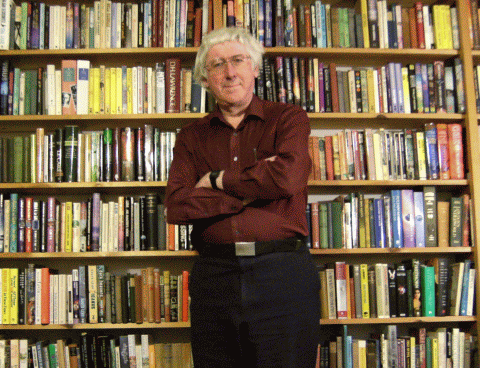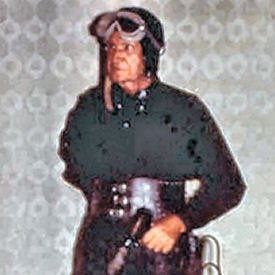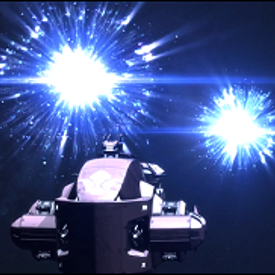 I was once the proud owner of a massive paperback tome, called The Encylopedia of Science Fiction. For a buff like myself it was an invaluable compendium of knowledge covering all aspects of the genre, from fiction to films. The Enclyclopedia continues to this day and in its latest manifestation, as a web-based encylopedia, it’s every bit as fascinating and wonderful as the original—and it keeps growing and growing. Its maintenance and development is down to two men in particular, David Langford and John Clute. The two men kindly agree to the interview which follows, and I’d like to thank them for the time and energy they put into their full and thoughtful replies.
I was once the proud owner of a massive paperback tome, called The Encylopedia of Science Fiction. For a buff like myself it was an invaluable compendium of knowledge covering all aspects of the genre, from fiction to films. The Enclyclopedia continues to this day and in its latest manifestation, as a web-based encylopedia, it’s every bit as fascinating and wonderful as the original—and it keeps growing and growing. Its maintenance and development is down to two men in particular, David Langford and John Clute. The two men kindly agree to the interview which follows, and I’d like to thank them for the time and energy they put into their full and thoughtful replies.
Abbreviations:. DRL: David Langford. JC: John Clute.

Tell us about the origins of the SF Encyclopedia.
DRL: It was originally the brain-child of Peter Nicholls in the mid-1970s, while he was living in Britain (he’s since returned to Australia and worked on the second and third editions from Down Under). He recruited John and a high-powered team of contributors, not including me since I was an extremely new young fan at the time. The great idea was to launch the first SF Encyclopedia at the Worldcon held in Britain in 1979, and to sell thousands of copies there. The publishers, with a supreme effort so characteristic of publishers, managed to muster a single set of proofs for display in the dealers’ room—but no finished books.

JC: We did not meet our deadline, of course, which was mainly due to personal paroxysms chez moi, including a move from London back to Toronto, then from Toronto back to London, just in time to miss my target for copy. But we weren’t that late. Explanation probably lies in the publishing scene back then, in the heyday of book packagers. Peter signed a work-for-hire contract with Hugh Elwes of Roxby Press, who in turn sold rights to Granada in the UK and Doubleday in America. We had no legal say in anything from the point of signature; and our influence on the publishing schedule was (I remember) non-existent.
The SF Encyclopedia has an astonishing breadth and scope. How do you go about gathering, not to mention assembling and keeping up to date, such a cornucopia of knowledge?
DRL: With great difficulty, and with a great deal of help. Again I must stress that I wasn’t involved until the second edition of 1993, when I helped a little with proofreading and Computer support. (We never did manage to extract the 1979 text from its eight-inch floppy disks readable only by one obsolete model of typesetting machine; it all had to be rekeyed.) Though I wrote many entries for the 1997 sister project The Encyclopedia of Fantasy, edited by John Clute and John Grant, it was only with the third incarnation of the SFE—planned for many years, launched online by Gollancz in October 2011—that I became a full editor and thus insufferable. Also new to the masthead of this edition is Graham Sleight. See our Introduction for Contributing Editors and others who get behind and push.
JC: As the 1979 edition was owned outright by Roxby Press, we did not know for over a decade (1) whether there would ever be a second edition or (2) if there were, whether we would gain sight again of those eight-inch floppies, which were designed to turn widdershins and were only readable by a handful of Singer typesetting machines, which may have all been junked by 1990. In the end, Peter Nicholls and I managed to buy the Encyclopedia from Roxby, at which point—as there was one less stage to go through to get anywhere—we contracted for a second edition with John Jarrold of MacDonald/Orbit. Part of the deal involved MacDonald having the 1979 text rekeyed by a thousand typists in the Far East.
During the interregnum between 1979 and 1990, I created and maintained an alphabetical list of entries, into which I fed anything I could find, Locus “Books Received”, gossip, deaths, whatever. I eventually called it the Dosbank, because it was maintained with an old MS-DOS program. For that matter, because it is convenient to do so, Roger Robinson (our Research Editor) and I continue to feed the list, which made my work on the Second Edition possible, and which has since grown to around 11,500 pages in a single document that we use as an aide-memoire and spur.
Both of you are known to many as key players in the evolution of the new wave of science fiction which originated in the UK. How important was that movement to current science fiction, or do you think that the genre simply continues to reinvent itself by dispensing with the old?
DRL: Maybe I should check the New Wave entry again: it certainly shouldn’t mention me. I missed that whole scene, really—unlike John—and only caught up with the extreme tail-end of the glory days in 1975 by selling a story, in fact a Parody of Mike Moorcock, to New Worlds in its New Worlds Quarterly incarnation. With a certain majestic inevitability, NWQ folded before publishing it.
 JC: I had some fiction and reviews published in the 1960s New Worlds, but didn’t really get involved personally until after I came to England in 1969. The New Wave was important for at least two things. Writers and artists, for maybe two years of pretty intense interaction, came together (or worked in solitude) to produce a lot of fiction and art that now seems interesting not only for what it represents but quite often because some of it was very good indeed. But second, and I think more important: the New Wave opened a kind of Pandora’s Box. We felt a bit like lungfish, belated lungfish to be sure: the beach stank with Modernist and Surrealist and Etcetera Spoor by the time we began to understand it was possible to breathe air; but the important thing was that we knew that we could from that point do and think what we wished. And (as I’ve suggested Mike Moorcock always knew when he let us say anything) pay for it.
JC: I had some fiction and reviews published in the 1960s New Worlds, but didn’t really get involved personally until after I came to England in 1969. The New Wave was important for at least two things. Writers and artists, for maybe two years of pretty intense interaction, came together (or worked in solitude) to produce a lot of fiction and art that now seems interesting not only for what it represents but quite often because some of it was very good indeed. But second, and I think more important: the New Wave opened a kind of Pandora’s Box. We felt a bit like lungfish, belated lungfish to be sure: the beach stank with Modernist and Surrealist and Etcetera Spoor by the time we began to understand it was possible to breathe air; but the important thing was that we knew that we could from that point do and think what we wished. And (as I’ve suggested Mike Moorcock always knew when he let us say anything) pay for it.
DRL: By the way, 2014 saw the fiftieth anniversary of the Moorcock takeover at New Worlds: I quoted a contemporary Newszine report in the March issue of Ansible.
I have the impression that science fiction per se (by that I mean what has come to be dubbed “hard” science fiction) is much less popular than it used to be, and sub genres like Steampunk, and medieval fantasies and genre mash-ups dominate the market. Do you believe that is the case? If you agree or disagree I would value your opinion on the state of the market at present.
JC: Maybe the secret is that a science fiction story cannot exist in a world which has become science fiction. Or, more accurately, science fictions….
DRL: While a few cunning authors surf the current trends by writing Hard SF (hardish, anyway) that displays the outward trappings of Steampunk or the New Weird but behind the mask wears a chrome-polished, rivet-studded smile.
The Encyclopedia has helped bring an academic rigour to the study of science fiction—which is not to discount the valuable science fiction courses offered by some universities, and individual commentators. What is it about this genre in particular, as opposed to crime and horror fiction, for instance, that makes it so worthy of in-depth study?
JC: Might have been more clearly the case in 1979, when what we did was attempt to establish a “playing field” within which a very broad-church definition of sf might be discussed. Though we were clearly prescriptive in our language at points throughout the enterprise (in fact a good deal more prescriptive than academics back then, still haunted by the objectivity mantras of the New Criticism), we were absolutely not prescriptive in what we deemed to be “worthy” of inclusion. Anything that fit the definition was our subject.
DRL: Perhaps one special attraction is the huge range of classifiable sf themes. The 1979 SF Encyclopedia didn’t just have entries for creators (authors, artists, editors and the rest) and creations (such as films and TV series), but many thematic overviews of sf topics like Space Flight, Time Travel and Immortality—entries that connected the more traditional encyclopedia articles in a network of enticing cross-references that lured the unwary browser from entry to entry and now, of course, have become hyperlinks. With the third edition appearing free of charge online and no space restrictions, we can indulge in smaller theme entries like Monomolecular Wire, Prime Directive, Ray Gun, Triffid and Universal Translator; or cross-link in a different way with geographical themes such as the new entries for London, New York and California.
If the full text can be read free online, what is the business model for the Encyclopedia?
JC: Orion/Gollancz pay a modest annual stipend for our work, and have connected the SFE to their SF Gateway ebook sales operation. We advertise Gateway and Gateway advertises us.
DRL: To expand: the SFE site design includes automatic linking of every book title in our voluminous author Checklists, to Gateway if the title exists there, otherwise to our own affiliations page (see the Shopping button to the right of every SFE entry). This nets us a tiny commission if visitors click through to buy the book—or anything else: we’re not proud—from Amazon, Book Depository or other vendors yet to be added. There is also a Donate option whereby you can contribute directly to ongoing expenses such as the editors’ weakness for food. Click early and click often!
David, both yourself and John Clute have made a mark as authors and as critics—your own Ansible newsletter and now website is well known to, and loved by, the science fiction community (Thog’s Masterclass being a particular favourite of mine), and John Clute writes incisive articles and reviews for the press. Basically—how do you find the time?
DRL: There may be a clue in the SF Encyclopedia entries on Clones and Doppelgangers. How we dispose of the crazed, burnt-out hulks of our “literary assistants” is a trade secret, but have you ever watched The Prestige?
JC: Like he said.
If you were to choose a few seminal works of science fiction that either inspired you or you believe are truly important works in the canon, what would they be?
DRL: Alfred Bester‘s The Stars My Destination alias Tiger! Tiger! is a perennial personal favourite. But I’ve made far too many lists of Important Influences and Top Science Fiction for SFX magazine—having written a column for every issue since it launched in 1995—and they come out differently every time. Gene Wolfe‘s The Book of the New Sun is usually in there somewhere, as is something (if not always the same something) by Ursula K. Le Guin.
JC: A kaleidoscope of choices hovers at the tip of the tongue, where it will remain I’m afraid: the best year for sf was 1953 because I was twelve turning thirteen then (see also Golden Age of SF). But David and I agree fully, I think, on the Gene Wolfe novel, which was maybe the first sf book that really made me read.
Where do you think science fiction is next headed?
DRL: The great paradox of the SF Encyclopedia is that spending one’s life annotating the sf field leaves less and less time actually to read the stuff. My mind is a blank.
JC: My mind is an attic. The elephant in the attic is Fantastika, the tank sf swims in. The task of Fantastika in 2014 is to ride the Amnesia/Vastation siamese-twin rollercoaster: combating the first, recognizing the second (for Vastation see Horror in SF). About to do BigThink. Must take my pills.
The Encyclopedia also covers science fiction art and Illustration, Cinema and even science fiction Fandom. Of these, science fiction film has had a much patchier history than the written word, with only a relatively small number of films or Television series that can stand proudly beside the best stories and novels. Why do you think this is so, and do you think the abundance of bad sf films has had a negative effect on the reading of science fiction?
DRL: Speaking as the sucker who edits the Ansible department Thog’s Masterclass, which (as you know, Professor; see Infodump; Clichés) showcases awful prose from professionally published works, I’d have thought that the novelists could give the film-makers a run for their money here. But of course second-rate movies – unlike bad novels, which tend to drop out of sight—are a cheap way to fill up TV schedules.
JC: Exam question: a CGI film like Gravity, in which there is no element of sf whatsoever, is properly understood as a pure sf story. Why is this?
Finally, what are your ambitions for the SF Encyclopedia, and your current plans for its development?
DRL: We’ve already received—very gratefully—the Hugo and other awards. Now we’re approaching four and a half million words of SFE entries (the first edition had a mere 730,000 words), and my great short-term ambition is to retain some vestiges of sanity long enough to steer this vast lumbering vessel past the five-million-word mark. As though the actual entries weren’t enough, we’ve madly invented time-consuming new features like the Picture Gallery, currently on course for ten thousand images. There’s an entry in the Encyclopedia somewhere for Ship of Fools….
JC: Which is to say we’re trying to bring the twenty-first century into sf.
Stop Press: At the time of going to publication with this interview, the Encyclopedia has just added some eye candy which David and John hope you will all enjoy.











4 Comments